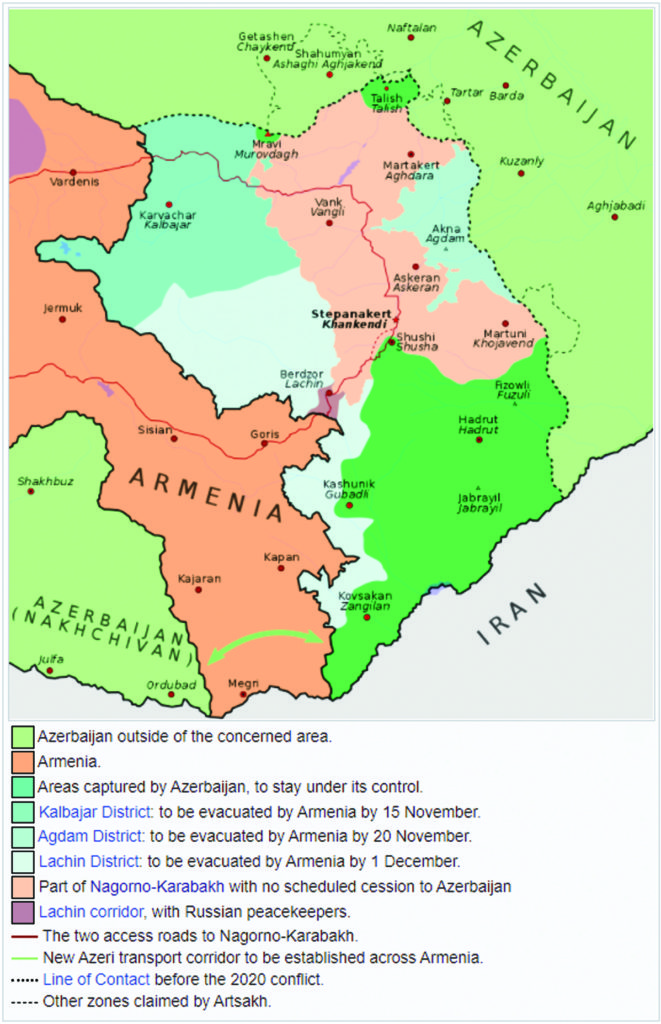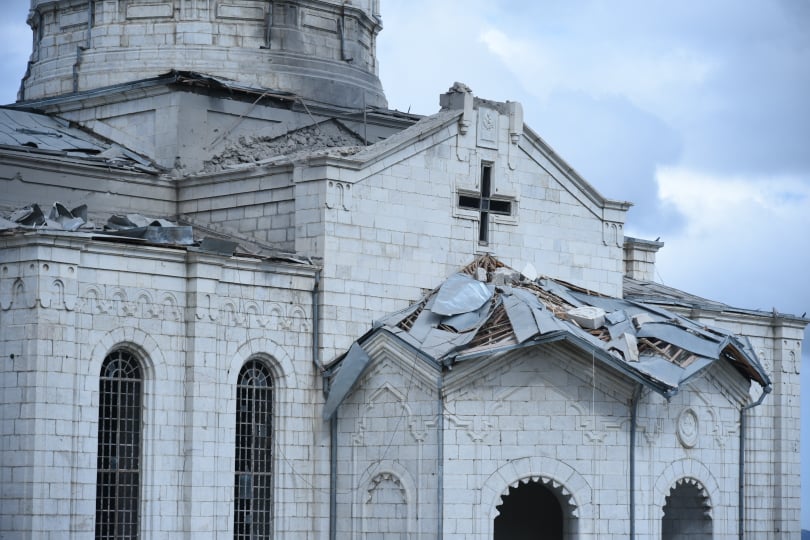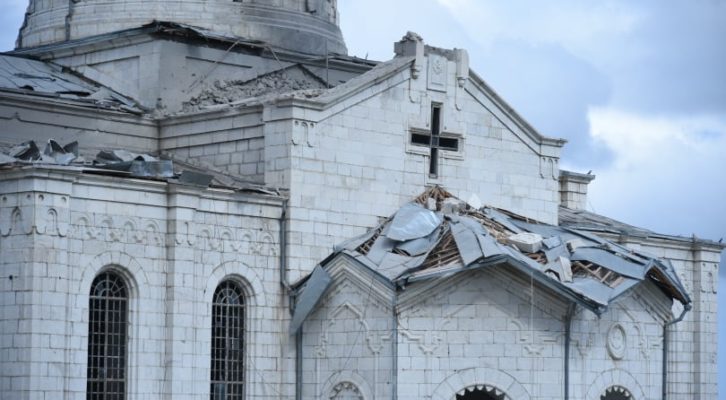
On November 10, 2020, Armenian Prime Minister Nikol Pashinyan announced on Facebook that Yerevan had agreed to a Russian-brokered armistice and thus cessation of hostilities with Azerbaijan. “I made that decision as a result of an in-depth analysis of the military situation and the assessment of people who know the situation best,” explained Pashinyan. “Also based on the belief that this is the best possible solution to the current situation,” he added.
The nine-point “ceasefire declaration” stated that Armenia would cede control of the Karvajar region by November 15 (later postponed to November 25) and Aghdam by November 20. Armenians will withdraw from Lachin (Berdzor), except for a five-kilometer-wide corridor, by December 1. It did not directly address the status of the parts of Artsakh proper that Armenian forces continued to hold, including the regional capital Stepanakert. For the Armenian nation, this was not just a national humiliation, but it was also a death penalty. According to the declaration, Artsakh’s second-largest city Shushi was to remain under the control of Azerbaijan. But days later both Azerbaijanis and Armenians realized its status was pending as Russia may have other designs towards the town. On November 14, Russian peacekeeping forces entered the outskirts of Shushi under the pretext of guaranteeing the safety of traffic along the Lachin corridor passing from Shushi to Stepanakert until a new route is established “by the agreement of the parties,” bypassing Shushi where a construction plan will be determined in the next three years. That is, Russian forces have guaranteed their military presence in Shushi for at least three years.
Even though the third point of the declaration mentioned that only “1,960 Russian military personnel with small arms, 90 armored personnel carriers, 380 military vehicles and other special equipment” will be employed in the Lachin corridor and Artsakh, the Russian military has reportedly deployed BM-21 Grad multiple launch rocket systems in the Lachin corridor (Berdzor). Armenian Telegram channel sources also claimed that the newest Russian electronic warfare system has been deployed where vehicles with the RB-341V “Leer-3” complex with “Orlan-10” unmanned aerial vehicles (UAVs) were seen when the Russian convoy was moving to the place of deployment. The Leer-3 complex itself technically consists of one KAMAZ vehicle with the corresponding filling and two (or three) Orlan-10 UAVs (drones). The drone has a range of 120 kilometers, time spent in the air – 10 hours, flight altitude – 5 km, speed: max – 150, cruising – 80 km/h. According to the same Telegram source, this drone can carry a different load and can perform the following actions: suppressing mobile communications; simulating the operation of a cellular base station in the GSM 900, 1,800, 2,000, 2,500 ranges; sending false messages; detecting phones and tablets; conducting reconnaissance; plotting the location of subscriber points on a digital map and transmitting data about the location of subscriber points to artillery crews for a fire strike. Depending on the equipment, the drone can work with subscribers at a distance of 3.5 to 6 kilometers. This drone was successfully tested in combat conditions in Syria. Russian Aerospace Forces also deployed Mi-8 and Mi-24 gunship helicopters.
An observer may wonder why peacekeeping forces need such heavy attack weapons. Will Russia give up easily on the strategic town of Shushi as its forces entered the outskirts of the city? Will it accept the Turkification of the stronghold of Artsakh? The main question is what will be or happen to the status of Shushi?
Well, it is unclear. It is still ambiguous. According to the declaration, it is part of Azerbaijan. But in reality, now that Russian peacekeeping forces entered the outskirts of the city, the city is surrounded by Armenian forces, and approximately 500 Azerbaijani forces are “trapped” (according to Azerbaijani social media posts).
On November 14, according to Azerbaijani opposition Meydan media, Azerbaijan officially asked the Russian Defense Ministry to provide them with a corridor to Shushi. Russia has yet to respond. The next day, General Rustam Muradov, commander of the Russian peacekeepers in Artsakh, met with Artsakh President Arayik Harutyunyan which infuriated the Azerbaijani side on social media and raised concerns over Russia’s future role in Artsakh. This was a de facto recognition of Artsakh authorities by the Russian side. Seymur Hazi, chairman of the opposition Azerbaijani Popular Front Party saw “Russian deployments pose a threat to Azerbaijan’s independence.” At the same time, Azerbaijani political analyst Rauf Mirkadirov called November 10 a “black day” for Azerbaijan’s independence since Baku had always avoided the presence of Russian troops on “its land.” However, Azerbaijani and Turkish mainstream media continue to portray the outcome of the war as “total victory.” Meanwhile, it seems while Azerbaijanis were celebrating the capture of Shushi and Armenians were mourning its loss, Russians may have other designs for the city. I propose three possible scenarios (assumptions).
- The Armenian side provides a corridor to Shushi, and in return, renegotiates to gain something. (Note: six days ago Russian media published maps saying the Armenian side has given villages in the Tavush region to Azerbaijan which the Armenian Foreign Ministry spokesperson denied. Russia later denied this too, while Azerbaijan keeps insisting.) Here, Armenia can push the issue of its southern transportation corridor that will link Nakhichevan to Azerbaijan proper. If clever enough, Yerevan can question the status of Shushi, gain time and not lift the blockade around Shushi thus pressuring President Aliyev to compromise. Moreover, Yerevan can lobby and push the OSCE Minsk Group to address the issue of Shushi and Hadrut that are part of Nagorno-Karabakh proper.
- Russia declares Shushi a no-man’s land (a clear violation of the statement) and proclaims that its status will be declared after the final agreement on the legal status of Artsakh. That is, Azerbaijanis will have to withdraw from a temporary corridor opened by the Armenian troops, and Russians may enter the center of the city. This could be less realistic at this moment as Aliyev wants to assert his influence and not lose Shushi for strategic and political reasons.
- Russian troops enter the center of Shushi and declare it an open city. Here, Yerevan and Stepanakert would have no choice but to push the right of return of Armenian refugees back to Shushi. If Baku raises the issue of returning Azerbaijanis back to the city, and in case of possible strife between the two communities, then Russia has no choice but to establish military rule in the city. On paper and in theory, Shushi would be an Azerbaijani city, but in reality it would be under Russian rule. Azerbaijan has only one solution, and that is to build a road through a hellish gorge from Hadrut or Fizuli (the construction process has already started). That will take months, if not years. Meanwhile, Armenia and Artsakh can push the issue of the return of Armenian refugees to Artsakh proper. On its turn, the Mother See of Holy Etchmiadzin can raise the issue of preserving Ghazanchetsots Cathedral and the surrounding churches and properties to be put under direct Russian protection.

Aftermath of Azerbaijan’s attacks on Shushi’s Ghazanchetsots Cathedral, October 8 (Photo: Armenian Unified Infocenter)
For this to succeed, ruling elites in Yerevan (whether the current or the future government) need Machiavellian diplomacy. While it is not possible to reverse what has been lost on the ground, there is some room to maneuver around the points in the declaration. Armenians can change the status of Shushi to their favor. Sometimes defeat can be transformed into a “small victory.” There are many examples in history, from the Ottoman defeat to Kemal Ataturk’s victory which was achieved by Machiavellian diplomacy and engaging between the Bolsheviks and the British/French. Armenia has the opportunity to turn the tide. France has declared its reservations with the agreement, but supported the halting of the fighting. The US and France (both co-chairs of OSCE Minsk Group) are not happy with Russia’s unilateral military role. Russia barely saved itself and stopped a complete Turkish victory and prevented Turkish military deployment in Artsakh. Iran has been isolated and “put out from the game.” Turkey is satisfied but concerned that it may lose Baku to Moscow in the future. While Azerbaijani officials are excited, many activists and the opposition on social media are publicly announcing their fears and talking about the Russian-planted “time bomb” in the South Caucasus. On Twitter, Azerbaijani activist Cavid Aga said that nationalists are now explicitly asserting that their government betrayed their promise and invited “Russian invaders.”
What remains for “defeated” Armenia is to gather its strength, bring new leadership a bit closer to Russia while also building bridges with Iran, the EU, US, China and India to get out of this trauma and come back to the negotiation table with a united front. To have this, we need domestic stability and trust. It is not too late, but time is not on our side.
On November 14, Russian President Vladimir Putin called his Azerbaijani counterpart and the latter assured that the “Christian churches and monuments in the territories that came under Baku’s control after the escalation of tensions in Nagorno-Karabakh will be protected by the state.” But there have been videos circulating on social media of the vandalism of Shushi’s Ghazanchetsots Cathedral. Another video depicts an Azerbaijani soldier destroying the cross over the church and praying the Islamic Azan. It is not clear whether the Russians reacted and entered the Dadivank monastery in Karvajar to save the Armenian Christian heritage from an “Albanization” process. However, what was remarkable was that Armenian priests returned to Dadivank and brought with them the church bells. One thing was clear: Moscow was not trusting Aliyev’s words. On the other hand, the question of Shushi remains unanswered. Will the Ghazanchetsots Cathedral have the same destiny as Dadivank of Karvajar? For this, the Armenian political and religious circles must engage in proactive diplomacy, lobby the OSCE Minsk Group and engage in continuous dialogue with the Kremlin over the status of Shushi and Hadrut.
The article was originally published in the Armenian Weekly.
Yeghia Tashjian is a regional analyst and researcher. He has graduated from the American University of Beirut in Public Policy and International Affairs. He pursued his BA at Haigazian University in Political Science in 2013. He founded the New Eastern Politics forum/blog in 2010. He was a Research Assistant at the Armenian Diaspora Research Center at Haigazian University. Currently, he is the Regional Officer of Women in War, a gender-based think tank. He has participated in international conferences in Frankfurt, Vienna, Uppsala, New Delhi, and Yerevan, and presented various topics from minority rights to regional security issues. His thesis topic was on China’s geopolitical and energy security interests in Iran and the Persian Gulf. He is a contributor to the various local and regional newspapers and presenter of the “Turkey Today” program in Radio Voice of Van.







